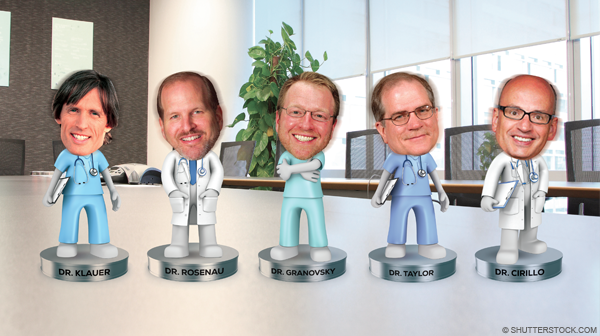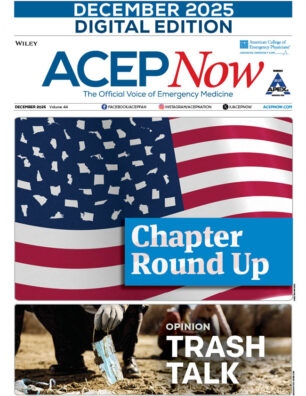
Five top voices in emergency medicine talk about the pros and cons of the Affordable Care Act
Introduction
With some of its most hotly contested provisions now taking effect, the Affordable Care Act (ACA)—or Obamacare, as both backers and detractors now call it—has been the object of admiration and animosity, of optimism and consternation. Hailed by some as the most significant health-care reform in a half century, it has been roundly scorned by others as an ill-advised debacle.
Explore This Issue
ACEP Now: Vol 33 – No 01 – January 2014Participants
Kevin Klauer, DO, EJD, FACEP, medical editor in chief of ACEP NOW and chief medical officer of Emergency Medicine Physicians
Alexander Rosenau, DO, FACEP, president of ACEP and senior vice chair of emergency medicine for the Lehigh Valley Health Network in Allentown, Pa.
Michael Granovsky, MD, FACEP, president of coding for LogixHealth
Todd Taylor, MD, FACEP, Veteran emergency physician, EMTALA and healthcare IT consultant
L. Anthony Cirillo, MD, FACEP, director of health policy and legislative advocacy for Emergency Medicine Physicians
Dr. Klauer: To jump in, what parts of the ACA are good, and what parts may positively impact emergency medicine?
Dr. Taylor: I think the good news is that there are some aspects that have already taken effect: children can stay on their parents’ plan until age 26; the controversial mandate for coverage of contraceptive services; the prohibition of denial for pre-existing conditions for children; prohibition from rescinding coverage; eliminating lifetime limits; regulating annual limits on insurance coverage; and that 80 percent to 85 percent of premium dollars, at least now for large employers, has to be spent on health care services.
The meat of the Act has not yet taken effect. Many of these extend to larger populations in 2014. The biggest is what’s called the minimum-coverage provision, otherwise known as the individual mandate. That requires most U.S. citizens and legal residents to maintain insurance coverage for themselves and their dependents, or they have to pay a 1 percent penalty of their total annual income or—at a minimum—$95.
It expands the pre-existing-condition prohibition to everyone, there are no annual limits on insurance coverage, it ensures coverage for clinical trials, and it adds mental-health and substance-abuse coverage for everyone—although this does not apply to Medicaid or Medicare. It expands prescription coverage. It provides preventative care, which is mostly free. It redefines pregnancy as preventative care, so it must be covered. Of course, that is under the terms of deductibles and coinsurance. And it caps the maximum out-of-pocket expense per individual at $6,350 a year, or $12,700 per family.
“So the jury is out. It’s going to be a long process that requires a lot of education, and the resources will have to be put there. We also have to be very careful not to create self-rationing or effective lack of insurance due to very high barriers of deductibles.”
—Alexander Rosenau, DO, FACEP
Dr. Klauer: Tony, anything to add to that?
Dr. Cirillo: I think the fact that there’s at least some hope that more people will have insurance coverage—even if that takes another seven or eight years down the road to get fully expanded out—certainly might help us.
The fact that we see so many patients, particularly on the admission side, I think will give us more leverage because the underlying driver for this is still going to be finances and how to pay for care for more people who are getting older and sicker. And I think it will give us more voice because we’re going to be a key player in deciding how best to do that.
Dr. Rosenau: What we found good is that one of the main goals of the Affordable Care Act—and of course, the word “affordable” remains to be seen—but the ACA is useful because by providing a means of payment, a means of insuring the whole population, we share the burden among more people, and that should eventually lower the cost per person—we’re hoping.
Dr. Klauer: Mike, anything else to add on that question? Anything in the ACA you see as really a windfall for emergency medicine?
Dr. Granovsky: One item that I’ll add, and it seems obvious at the surface, is the inclusion of emergency department care, which ACEP advocated and supported, as one of the essential health benefits so that ED care is required to be a covered service. Now the degree to which that coverage ultimately leads to remuneration for our members remains to be seen, but ED care is a defined, covered service as an essential health benefit.
Dr. Klauer: You mentioned, Todd, that there were caps on the out-of-pocket expenses for the insured. If your deductible is $10,000, are they really capping your expenses at $6,350? Then your deductible isn’t really $10,000. So what are your comments on that?
Dr. Taylor: One of the impacts of the website [http://healthcare.gov] unavailability is that people really haven’t gotten all of the information. The maximum out-of-pocket is $6,350, so you really don’t see deductibles above that, but you do see some plans that have a $6,350 deductible. Beyond that, there’s no coinsurance, no co-pays, or anything else because that’s the maximum out-of-pocket. The rest of the plans are really just some mathematical derivation of that, and if you really start to delve into them, what you’ll see is that as you get to the lower deductible amounts, the premiums increase to an extent and the coinsurance increases to an extent that essentially you’re better off, if you have the resources, to go with a high deductible—say, a $5,000 to $6,000 deductible—pay the lower premium, and save that money toward whatever health-care services you may incur.
So one of the impacts of the way this has been structured is that it is forcing first-dollar coverage onto individuals and basically making them self-insure.
What’s funny about it is that when you take into account the individual cost from coinsurance and deductibles and then you add in the additional amount of premium you’re going to pay for a lower coinsurance or deductible, and you take pregnancy as an example, you just about pay the same amount out-of-pocket regardless of plan. And that amount out-of-pocket is almost the entire cost of the pregnancy.
“If the good news about the Affordable Care Act is that in half the states we can look forward to more Medicaid patients, then I think that fairly well summarizes what we can expect for emergency medicine in this initiative.”
—Todd Taylor, MD, FACEP
Dr. Granovsky: I’ll just add here, related to the out-of-pocket maximum. The out-of-pocket maximum seems like it will apply to co-pays and coinsurance. The patients’ premium costs, which are paying for the actual coverage, may in the end actually be layered on top of that. And depending on the way that the insurance product is set up that you purchase, you may be on the hook for prescription drug co-pays in addition to the $6,350 out-of-pocket maximum.
In fact, I’m in the process of shopping for my own family’s health insurance, and the prescription coverage is an area where there’s a lot of opportunity for the issuers, the insurance companies, to pass on costs. As an example, a typical plan that I looked at just yesterday was a $10 co-pay for a generic drug but 40 percent coinsurance for a non-generic drug. The math changes very quickly. That non-generic drug, which happened to be Protonix, was going to be $100 for a 60-day supply.
Dr. Klauer: So this is for all of you: we’ve got a system in place, so we do have some form of access to health insurance but not necessarily health care. So is this really just an illusion of coverage to the average citizen, or is there true coverage? In other words, with such high deductibles, are we effectively just adding to the ranks of self-pay patients?
Dr. Rosenau: I don’t think it’s fair to say it’s just an illusion of coverage, but it’s like everything else: the devil’s in the details. So the jury is out. In order to get to the point where the Affordable Care Act works well for everyone, it’s going to be a long process that requires a lot of education, and the resources will have to be put there. We also have to be very careful not to create this self-rationing or effective lack of insurance due to very high barriers of deductibles.
Dr. Granovsky: I want to tie back to the very last thing that Kevin said, which is people who are self-pay. Many of the people who are currently self-pay will move into Medicaid products if that state has opted to expand Medicaid. And then the discussion that we’re having is very different. Some states do have a shared portal for their Medicaid products and their health insurance exchange commercial plans. But for most states, the Medicaid enrollment process and the Medicaid benefits are very different than the health insurance exchange process. There’s very little in the way of co-pays, coinsurance, and patient responsibility if you make less than 138 percent of the federal poverty limit and your state has opted to expand Medicaid.
You would find yourself with new Medicaid coverage when you were previously self-pay, with very little in the way of patient responsibility. Then we’ve got the health insurance exchange products, where the subsidies run for individuals with adjusted gross income between 138 percent and 400 percent of the federal poverty limit, and that’s the process that we’ve been discussing now. I just wanted to make that distinction.
“The offer of health insurance ‘coverage’ is essentially false advertising. What really matters is what the out-of-pocket maximum is under the plan and how much ‘real money’ individuals and families are going to have to come up with.”
—L. Anthony Cirillo, MD, FACEP
Dr. Klauer: Tony, what are your feelings about whether this is just the illusion of health-care coverage? If people really are not going to want to pay this out-of-pocket expense anyway, they’re going to be in the same situation they’re in now. What do you think?
Dr. Cirillo: Let me give you a real-world example because I’m actually on the Connecticut exchange website right now. If you have a family of four in Connecticut, and I did two adults and two teenage children with an annual income of $60,000—that’s gross income—there are four silver plans that are available through the Connecticut marketplace, the cheapest of which, after a $520 tax credit, is $405 a month.
So that’s the premium. The max out-of-pocket for the year is $12,700, and it comes with a $6,000 deductible. So I would pose to the group: if you’re a family of four making $60,000 a year and you have to shell out $5,000 a year in premiums and you’re on the hook for $6,000 to start with, are you really going to be able to afford that coverage?
Dr. Klauer: So when it comes down to it, this is a shell game. You’re still paying $11,000 before anybody pays one penny of coverage for your family.
Dr. Cirillo: That’s correct. And your primary-care visits have a $30 co-pay. As Mike pointed out, there are three concepts that people need to consider when they’re looking at this—really four. OK, I’ll give you five: What’s the premium? What’s my deductible? What are my co-pays? My coinsurances? And then, what’s the maximum that I’m on the hook for when I get my card?
Dr. Klauer: Is there any carve-out in any one of these plans that you’re aware of that says, but if this is an emergency, we cover more of this or you don’t have to meet the deductible?
Dr. Taylor: I’ve looked at that specifically. So emergency care is included in the deductibles, and it’s actually worse because some of the plans require a facility fee of up to $500. So even if you have a low deductible and reasonable coinsurance, you’re going to have that minimum of a facility fee, and that also applies to some plans with regard to hospitalization admission on a per-day basis. You may have to pay up to $2,000 per day.
Dr. Klauer: What you two have said leads me to what I think is an obvious question: If we have people in the insurance pool right now who maybe don’t have great plans but they have coverage and now they’re going to switch over to this type of system, are we at risk of converting people who were going to be covered patients in the emergency department to patients who are now effectively uninsured self-pays in the emergency department? Is this negatively impacting our situation in the emergency department based on these plans?
Dr. Taylor: We probably don’t functionally impact those who are currently uninsured. However, once the employer mandate starts, you’re going to see shifts in those plans where I believe we will be creating an underinsurance situation, or what I like to call functionally uninsured, throughout the current insured population. So the scenario that Tony mentioned I believe will expand to a large segment of the population, and the ultimate result is that the immediate dollars available for emergency care will decrease and we’ll be chasing individuals for their deductibles like we have never seen before.
Dr. Klauer: We have people who, perhaps, have decent plans now who’ve got to choose one of these new plans. If they elect not to do it or they end up having a high deductible and they come to the emergency department—where, a year ago, their plan would have paid us something—now it’s all their burden, and we may not be able to get anything from them. Until they meet their deductible and premium, they’re effectively a self-pay to us.
Dr. Taylor: Well, you’ll be able to get something from them, but you’re going to have to chase it; it’s much more difficult. The days of submitting a bill to their insurance plan and getting a check in 30 days I believe will be largely gone, and you’ll be chasing this money for months.
Dr. Granovsky: In 2003, tax-law changes facilitated the growth of high-deductible health plans, and we had 8 million enrollees in high-deductible health plans in 2010 and 13.5 million in 2012 and over 15 million in 2013. And the experience has shown exactly what both Kevin and Todd are saying. We actually have the experience already: those dollars are harder to collect.
Dr. Klauer: That brings me to my next question: How do you think the Affordable Care Act will impact reimbursements, short-term and long-term?
Dr. Granovsky: There is a silver lining, which is the Medicaid expansion for states that opt into that expansion. The typical self-pay collection runs $15 to $20 per visit. The typical Medicaid payment for an ED visit to physicians is between $50 and $80. And over time, some modeling has shown that you could see a shift of 7 percent to 10 percent of a given ED’s patient population moving from self-pay to that state’s Medicaid pool. Medicaid doesn’t pay quickly, the rates aren’t so robust, but nonetheless, you could see a difference of $50, $60, $65 a patient, which for a typical 40,000-visit ED could create $150,000 in additional revenue.
However, that would all be offset by high-reimbursing patients moving into health insurance exchange products. Our general feeling is that it will trend toward Medicare or close to Medicare rates from what now are much higher rates.
Dr. Klauer: Tony, quick question for you. If Medicaid expansion could almost be a safe harbor in this plan that in some way helps us or protects us, is that going to be a place that we’re going to drive emergency care?
Dr. Cirillo: There are 25 states plus the District of Columbia that have opted to expand and 25 that have opted not to. In those states that opt not to, not only are there still going to be people who are more self-pay when they could have been covered by Medicaid, but those hospitals are still going to lose their disproportionate share payments. So I will tell you that the people working in those hospitals are going to continue to see self-pay patients, and their hospitals are going to be put in a more financially challenging position.
I think the other issue is that, remember, there are only two states that pay above Medicare for Medicaid patients, and that’s North Dakota and Wyoming. So if you practice there, you’re doing OK, but many states pay 25, 30, 40 cents on the Medicare dollar. So although it will be better than nothing, I agree with Mike: the reality is that it’s not much better than nothing, and you’re still going to have to work so much harder to get that first dollar out of the patients who have these pseudo-insurance cards. I don’t see this as being a magic windfall for emergency medicine in any way.
Dr. Klauer: Tony, just for the readers, give us a one- or two-liner defining disproportionate share.
Dr. Cirillo: The Disproportionate Share Program, or DSH, is a program that essentially provides federal dollars to help offset the cost of care provided by hospitals to patients who are self-pay or “indigent.” Each state receives a payment annually, and then the states decide how to divvy up those funds among their hospitals by some formula that the feds have created to determine the dollar amount.
Dr. Granovsky: To build on that, if you are in a non-Medicaid-expansion state, you are losing, as Tony said, your DSH payment. Those payments support, in part, resident-driven or public-facing free clinics or indigent-care health-care access. So now you didn’t expand Medicaid if you’re in a Gulf state, let’s say Texas, Louisiana, or Mississippi. And the resources, the revenues that the hospital uses to fund its indigent care have now dried up. Where do those patients go? They only have one place left: the front door of the hospital’s emergency department.
Dr. Taylor: Just to add to that discussion, patients in this gap are exempt from the mandate based upon their income. So you create a situation where you don’t provide Medicaid to them and they don’t have the individual mandate.
If the good news about the Affordable Care Act is that in half the states we can look forward to more Medicaid patients, then I think that fairly well summarizes what we can expect for emergency medicine in this initiative.
Dr. Klauer: Thank you for that ray of sunshine, Todd. So how will the ACA impact reimbursement—short-term and long-term? Mike?
Dr. Granovsky: Medicaid will expand over time. The Massachusetts experience was that it took three to five years until everybody who could be insured would be insured. The movement into the health insurance exchanges will also take time, and it seems like the federal government is backing off of that by delaying the employer mandate by a year. And I agree with Tony: I think a lot of that will then lead to reconfiguring of the workforce to below the mandated 30-hour cutoff that requires employers to have coverage.
As more and more patients move into the exchanges, we will see ED reimbursement for the higher-end commercial plans driven down closer to Medicare levels.
Dr. Klauer: So is this model sustainable, Tony?
Dr. Cirillo: The answer, to me, is no. The fundamental reasons why we spend money on people haven’t changed. So we haven’t had any discussion, and I will fault the medical specialty for not doing this. Ten years ago, we could have had a discussion, honestly, with the people whom we refer to as “The Greatest Generation,” who understood the concept of self-sacrifice for the greater good. We could have had a discussion about, hey, let’s really talk about what people really want for health care as they get older and what should we really tell them about what it’s like to go to the cardiac cath lab at 90 and go to the ICU.
Dr. Klauer: So our problem is we still treat health care in this country as a right, but we’re funding it as a privilege, and this law doesn’t change that.
Dr. Cirillo: We treat it as something that we have to do because we have the possibility of doing it. And we stopped being thoughtful and mindful about what we should do.
Dr. Klauer: Todd?
Dr. Taylor: With the Affordable Care Act, we now treat health care as a fundamental right, but we are now funding it as mandate, and I think that’s the difference.
Dr. Klauer: So do you think it’s sustainable, Mike?
Dr. Granovsky: Not sustainable under it’s current form.
Dr. Klauer: Todd?
Dr. Taylor: OK, I have to explain why it’s not sustainable. The idea, under the Affordable Care Act, was to get everybody to contribute into the insurance pool and then spread the risk across the entire pool. The problem is that this scheme does not accomplish that and, in fact, makes it worse.
Dr. Rosenau: I’m like the rest of the population: I have to reserve judgment. I’m not sure. I know that I live by the values that I heard when they first talked about the Affordable Care Act, which was we have 47 million Americans that are uninsured and don’t get proper health care because of that. We’re living in a divergent system where some people get one level of health care and the other one-sixth, the other 47 million, do not. I would like to see a consistent level of health care be provided to all of our citizens, and I think that we have to find a way to do that in an affordable manner.
Bryn Nelson, PhD, is a medical journalist based in Seattle.







2 Responses to “What Will Obamacare Mean for Emergency Physicians?”
January 12, 2014
jpedmdRe. Dr. Klauer’s comment “So when it comes down to it, this is a shell game. You’re still paying $11,000 before anybody pays one penny of coverage for your family.”
This is just wrong, especially for the example cited – a family of 4, presumably with 2 children and 2 adults. Remember there is substantive free preventative care mandated under the ACA that is often the predominant type of care needed for young healthy families. See:
https://www.healthcare.gov/what-are-my-preventive-care-benefits/
May 27, 2015
Pennsylvania Governor Acts to Ensure Federal Health Care Subsidies - ACEP Now[…] Pennsylvania Governor Tom Wolf said on Friday the state will set up its own health care exchange if needed to save insurance subsidies for thousands of residents under the federal government’s 2010 Affordable Care Act. […]